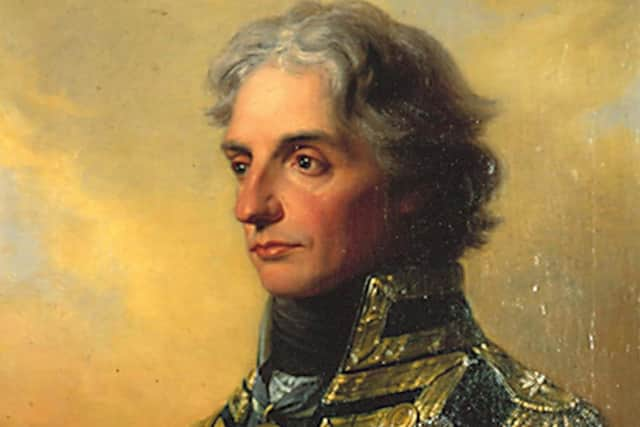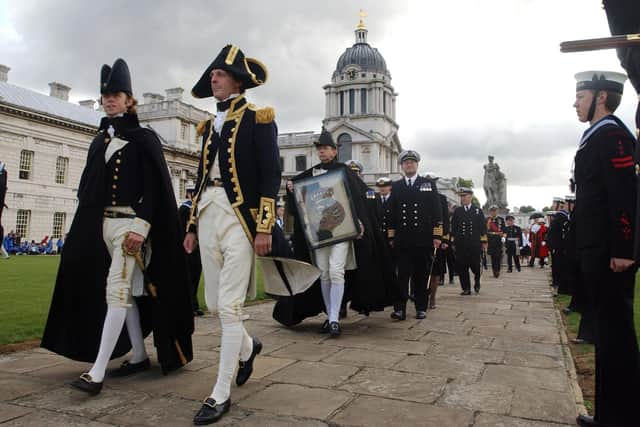Legendary Lord Nelson is remembered on the centenary of his death (1905)
and live on Freeview channel 276
In the Guild Hall, Newtownards, on the afternoon of the 21st October 1905, a largely attended demonstration in honour of the centenary of the death of Nelson was held under the auspices of the British and Foreign Sailors’ Society.
Mr T L Corbett, MP, presided. The proceedings opened with the singing of the 100th Psalm and prayer by the Reverend James Salters, MA.
Advertisement
Hide AdAdvertisement
Hide AdThe chairman, who was heartily received, said he feared that they lived in “somewhat materialistic days”, when men “thought more of creature comforts, luxury, and pleasure than of high ideals and of hero worship”.


Mr Corbert remarked: “Perhaps there is less hero worship because there are fewer heroes; anyhow, it would be a bad day for our country when enthusiasm and hero worship disappeared.
“It is well, therefore, to turn to the records of the glorious past. They give us inspiration for the present and hope and courage for the future. I am glad, therefore, to celebrate with you the glorious memories that gathered round the name of Nelson.”
Mr Corbett continued: “Two great names stand out like mountain peaks in the history of our country at the beginning of the last century – Wellington and Nelson. Both will forever command the admiration and the undying gratitude of their countrymen.
Advertisement
Hide AdAdvertisement
Hide Ad“But for the personality of Nelson a feeling of affection is added; he was ardently loved as well as respected by his men. He had the magnetic attraction of sympathy, as well as courage and devotion to duty.


“A gentleman once told me a story that he had never seen mentioned that illustrated this quality. His grandfather was a midshipman on the Victory, and shortly before the battle of Trafalgar the despatch boat left the fleet with the mail for England.
“When she had gone the young midshipman rushed up with a letter in his hand, but too late. Nelson happened to pass at the moment, and seeing the disappointment in the young fellow’s face, signalled to recall the despatch, boat, saying, ‘Poor boy, he may never write to his mother again’.
“A hundred years had passed since that scene and the battle that followed, but his famous signal still stirs the pulses and shapes the purposes of his countrymen from generation, to generation. He died with one desire, to do his duty, and ‘Not once or twice/ In our rough island story,/ The path of duty, was/ The path of glory.’”
Advertisement
Hide AdAdvertisement
Hide AdMr Corbett concluded: “It is well to have our enthusiasm stirred by such memories. It is also well to have it directed in practical channels, and there can surely be no good work more naturally allied to the memories of the day than the work of the British and Foreign Sailors’ Society, and no class who more appealed to our imagination and sympathies on such an occasion than the brave men who go down to the sea in ships, the sailors whom Nelson loved so well.”
Meanwhile, the Nelson centenary had also been “enthusiastically celebrated” in Enniskillen on 21st October, 1905, reported the News Letter.
A “large and most representative audience assembled” in the Town Hall, where, on the motion of the Reverend Randall Phillips, seconded by the Reverend S C Mitchell, the chair was taken by Mr E M Archdale, DL. The proceedings opened with the ringing of six bells, after which the chairman expressed his pride at being, as a representative of the navy, chairman of the meeting, “called to commemorate the death of a hero who belonged to the finest service in the world”.
After the singing of The Death of Nelson, the Right Reverend Dr D'Arcy, Bishop of Clogher, in the course of a short address, said they had just heard a splendid old song, which recalled to mind the thrilling time when Great Britain had been confronted with the greatest danger known in history.
Advertisement
Hide AdAdvertisement
Hide AdHe said: It was Nelson who had been enabled, through the providence of God, to check the spread of Napoleon's empire and to prevent an invasion of England, and it was that great deed which has ultimately secured peace for the whole of Europe.”
He added: “Great Britain stands both for civilisation and humanity, and proved successful through Nelson's heroic work at Trafalgar. Nelson, coming from a rector's simple home, accomplished that great deed, he was a man full of devotion to his God and his country.
“We honoured the great hero today in a fitting manner, for, although we are in an inland town, we must admit all we owe it to the British navy; for, when invasion threatened, we all look forward to our first grand line of defence – the navy.”
Lord Erne also addressed the meeting at Enniskillen.
He said: “So long ago was it since the death of that great hero. Many of us might be prone to under-estimate the advantages reaped by this country as a result of his achievements.
Advertisement
Hide AdAdvertisement
Hide Ad“But for Nelson, the map of Europe would be painted today in different colours. I have read a history of Nelson's life, and I think that the character of the great hero was tersely summed up in a few sentences, for it described Nelson as a man of indomitable courage, of wonderful tenacity of purpose, of devoted patriotism, and inspired strategy.
Lord Erne concluded: “Nelson has left us an example; he has also left this country mistress of the seas, and it was our duty to see that it does not suffer at our hands.”